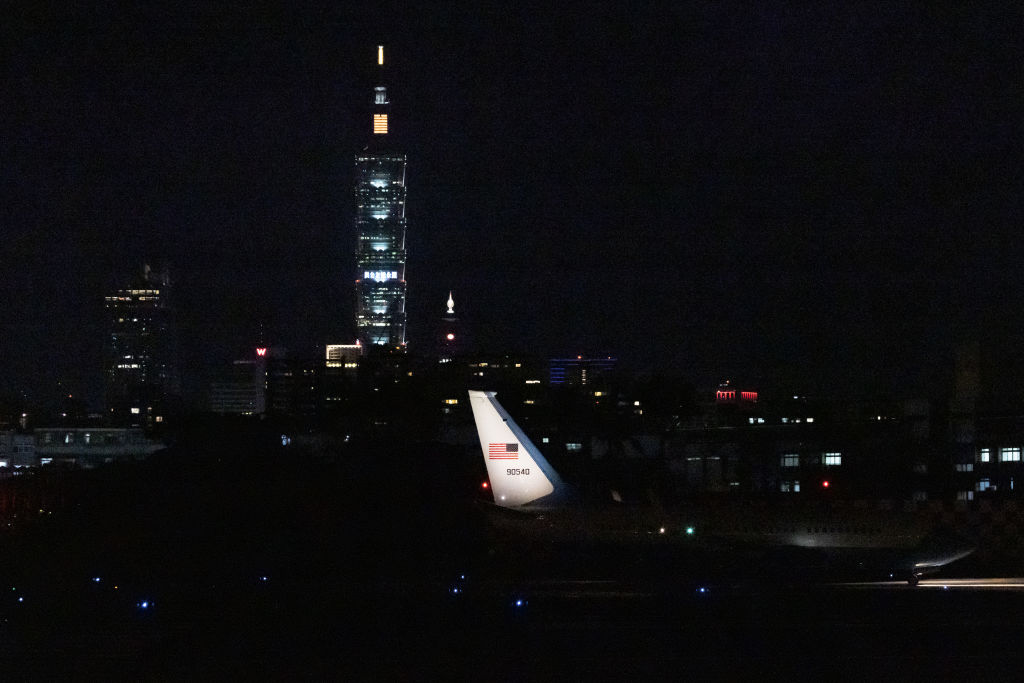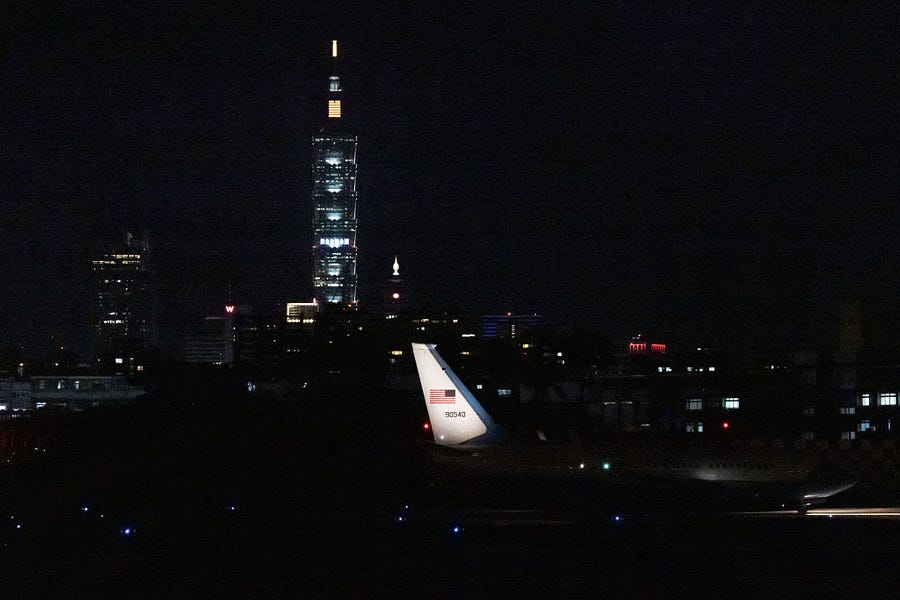While this newsletter is about China, I’m not forgetting that the United States won a great victory this weekend. We finally tracked down and killed Ayman al-Zawahiri, the leader of al Qaeda and one of the masterminds of 9/11. Steve Hayes, Klon Kitchen, and I will be on Dispatch Live tonight to talk about Zawahiri, China, and Russia.
Dispatch Live is for Dispatch members only, so if you haven’t joined yet, now’s your chance. Subscribe here before 8:00 p.m. ET, and you can watch us live and ask questions. See you soon!

There is an admirable consistency to Nancy’s Pelosi’s long opposition to the communist Chinese regime. Thirty-one years ago Pelosi stood alongside representatives Ben Jones and John Miller in the heart of Tiananmen Square and unfurled a banner that read, “To those who died for Democracy in China.” Police responded immediately, “roughing up” journalists who covered the moment and chasing Pelosi and her colleagues out of the square.
She has confronted Chinese leaders directly about the plight of political prisoners. She has opposed Chinese efforts to host the Olympic Games. She has taken House members to Tibet. And today she became the highest-ranking U.S. politician to visit Taiwan since then-Speaker of the House Newt Gingrich visited in 1997. And she did it in spite of explicit Chinese threats against her flight, in spite of explicit Chinese warnings of military escalation, and in spite of administration misgivings.
We are witnessing an important moment, for important reasons that go beyond Pelosi’s visit. While the eyes of the world were (rightly) focused on Pelosi, how many people were also tracking this report about the U.S. Pacific Fleet:
Three US Navy ships, an aircraft carrier, and two amphibious assault ships carrying stealth fighters are operating in waters near Taiwan as China doubles down on its warnings of a possible military response should House Speaker Nancy Pelosi go through with a visit to Taiwan.
The three ships are the USS Ronald Reagan, the only forward-deployed aircraft carrier, USS America, and USS Tripoli, according to a USNI News report.
Those three ships (along with their escorts) represent an immense amount of combat power. While the world knows the combat capabilities of an American fleet carrier and its air wing, fewer people understand the importance of both the America and Tripoli. The Tripoli is reportedly testing the viability of the so-called “lightning-carrier” concept, which can put as many as 20 F-35B fifth-generation fighters on each assault ship.
The America has also operated F-35s from its deck, including in operations in the South Pacific. Here’s the concept in operation:
Taken together (especially when combined with Taiwan’s own fleet of advanced fighter aircraft), the total allied force available to confront China right now is sufficient to inflict staggering costs on the Chinese navy and air force should it choose to intervene. The end result is a demonstration of resolve (Pelosi’s visit) and capability (fleet deployment) that represents the right way to maintain deterrence against catastrophic Chinese aggression.
Why emphasize the combination of resolve and capability? Because both are necessary. Resolve without capability is a formula for suicide. It courts conflict without the ability to respond. Capability without resolve is a formula for surrender. It cedes territory to your enemy through your own timidity.
History is replete with examples of each mistake. When Saddam Hussein invaded Kuwait and then fortified against the allied response, he demonstrated an immense amount of resolve. But he didn’t possess the capability to deter the American-led counter-attack.
When Hitler initiated any number of pre-war crises, from remilitarizing the Rhineland in 1936 to the Czech Crisis of 1938, the allies possessed the capability to intervene and defeat Nazi Germany. They lacked the resolve.
American defense policy in the Taiwan Strait has long rested on a policy of “strategic ambiguity.” The reason for the ambiguity is straightforward—the lack of an explicit defense agreement with Taiwan has allowed the United States to maintain relationships with both nations and prevents Taiwan from taking unilateral actions (secure in the knowledge of American support) that would inflame tensions with the mainland.
But the ambiguity also deters the mainland. The thought that America might intervene in the event of a conflict changes China’s military calculus. It can’t presume that it will fight Taiwan’s military alone. It has to consider the very real possibility that it will face the U.S. Pacific Fleet in the short term, and the full might of the American military in the long term. Simply put, China is not ready for that confrontation.
I like the way Steve Goldstein described the policy in a piece last year for the National Bureau of Asian Research:
Strictly speaking, strategic ambiguity is not about whether the United States would intervene should either side upset the present status quo by initiating a cross-strait conflict, as is commonly assumed. Instead, it is about providing conditional clarity regarding the circumstances under which intervention by the United States would be appropriate. It creates a type of “dual deterrence” in which both sides are deterred from endangering the status quo by the possibility of U.S. intervention while at the same time being assured that the other side will not unilaterally seek to change the status quo.
Put another way, there are circumstances where strategic ambiguity becomes less ambiguous. If Taiwan clearly initiates the conflict, then it should assume that U.S. help is not on the way. If China initiates, by contrast, then China should assume that a U.S. response is highly likely.
Thus, for strategic ambiguity to work, there are moments where the ambiguity has to become less ambiguous. If aggression from China isn’t countered by a ramped-up American response, then ambiguity is empty. We demonstrate neither capability nor resolve. But when China threatens the life of our speaker of the House, then sees three of the most powerful warships afloat (carrying the most advanced fighter aircraft in the world) all within striking distance of the Chinese mainland, then they see Pelosi’s resolve supported by the Navy’s capability.
I should note here that people I respect disagree with me. They see Pelosi’s trip as a provocation without a purpose. They see the gap between Pelosi and the Biden administration as evidence of U.S. uncertainty, and they crave more clarity. President Biden, for example, has pledged to defend Taiwan, only to have his administration walk back his comments.
Bonnie Glaser, director of the Asia program at the U.S.-based German Marshall Fund, told The Guardian:
There have been many statements about our policy toward Taiwan, some of which have been contradictory, and there is a need for some consistency and clarity in US policy. One of the reasons why China is responding as it is—and there are many drivers—is that they are losing confidence in the U.S. commitment to One China and they see a gap between U.S. words and deeds.
All of this is entirely fair, and it’s important to note that critics of Pelosi’s visit may well be right. It might ultimately do more harm than good. Maintaining peace is hard. Great power diplomacy is hard.
Yet a policy that defers to Chinese bluster has its own risks. While defying Chinese rhetoric does increase tensions—at least in the short run—it’s also true that establishing a pattern of unilateral de-escalation can embolden aggressors and, perversely enough, increase the chances of catastrophic conflict. History is littered with examples of aggressive miscalculations by expansionist dictators, and we’re living with the consequences of just such a miscalculation by Russia in Ukraine today.
One final note—I was pleased to see that 26 Republican senators issued a statement supporting Pelosi’s visit. America isn’t entirely lost to mindless partisanship. There is longstanding bipartisan support for a free and independent Taiwan, and this bipartisan support means that even sometimes-angry domestic political rivals can lock arms to confront genocidal tyrants abroad. I liked this sentiment on Twitter:
Well said. I’ve had many, many differences with Nancy Pelosi, but she’s doing something today that is bold and good—backed by the immense power of the United States Pacific Fleet. This is her moment. This is the Navy’s moment. Their resolve and their power are the key to peace.







Please note that we at The Dispatch hold ourselves, our work, and our commenters to a higher standard than other places on the internet. We welcome comments that foster genuine debate or discussion—including comments critical of us or our work—but responses that include ad hominem attacks on fellow Dispatch members or are intended to stoke fear and anger may be moderated.
With your membership, you only have the ability to comment on The Morning Dispatch articles. Consider upgrading to join the conversation everywhere.